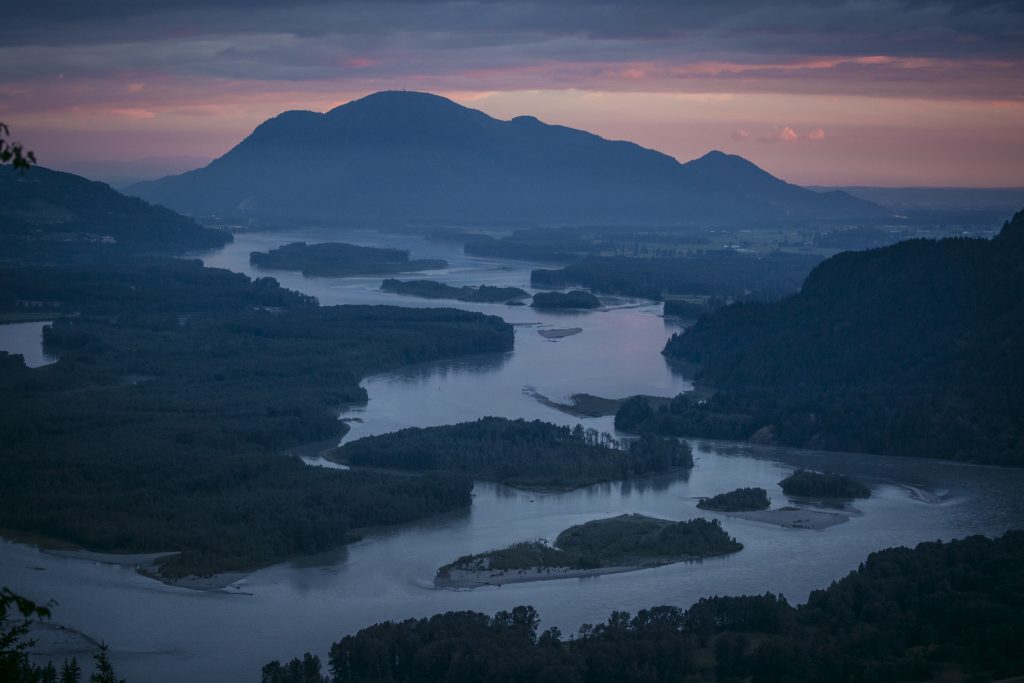
Introduction: Wild Salmon Chase
Most people know Vancouver, British Columbia as a thriving, modern metropolis of the Pacific Northwest—the last stop before civilization gives way to the wilds of the province. Salmon know it as the last obstacle to pass through before they make it from Hope to the Salish Sea on their journey through the Lower Fraser River Valley.
Sockeye, pink, chum, coho, and Chinook. They run to the sea, only to return, each generation pulsing back to their natal waters of the Fraser River.
Salmon are as much embedded in the lifeblood of Vancouver as they are a mirror to the city’s struggles. Like so many regions today, the city seems struggling upstream toward a rebirth; battling back the heavy currents of change and development.
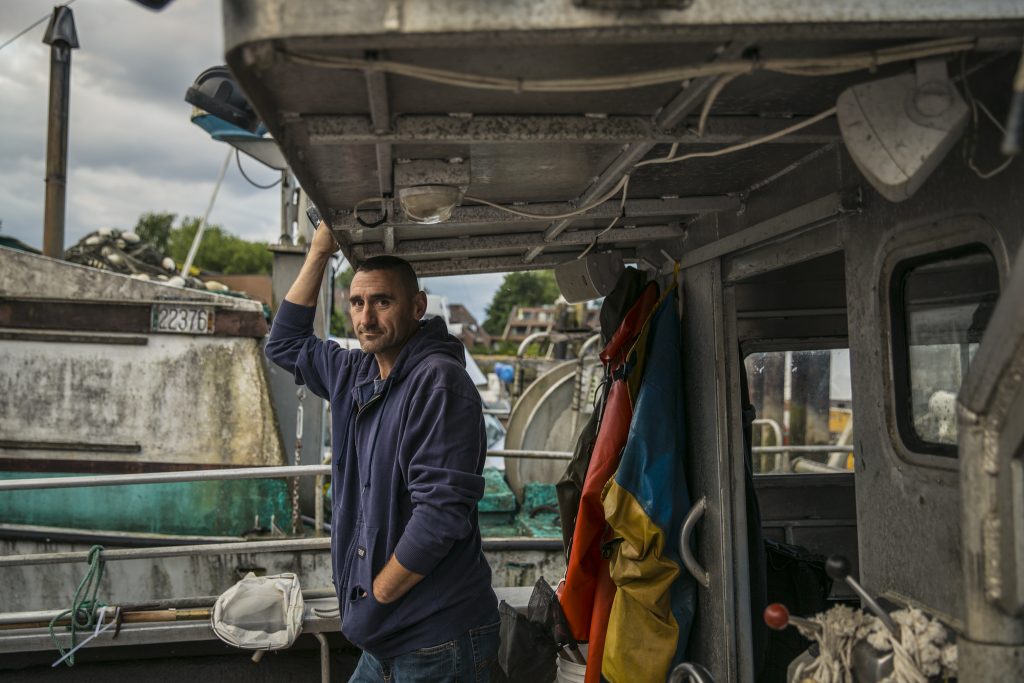
This is the story visible from the surface.
Instinct drove us, outsiders, a pair of Northeasterners with a soft spot for endangered species and a good story, to dip below. And so, the Lower Fraser River Valley region was revealed through the fractured light of competing desires occupying the same prismatic conundrum—the salmon are disappearing.
***
Part I: The Real Science of Salmon
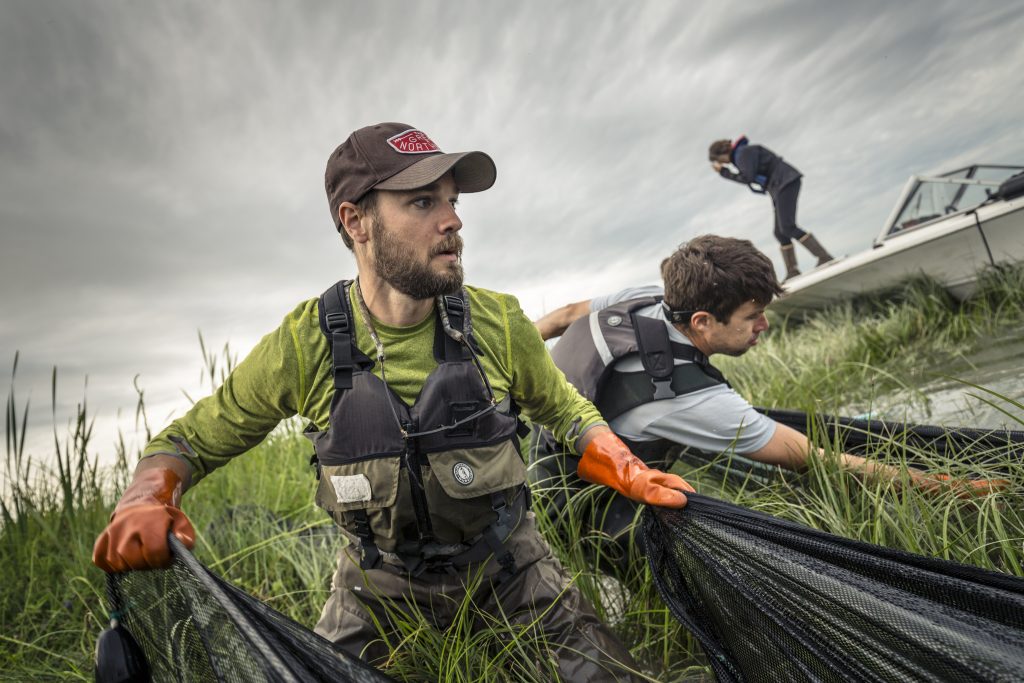
The small boat cuts through the channel on the south side of Westham Island as the sun rises behind us, tentacles of warmth touching between tall pines. The moon hasn’t yet given up the sky.
We are loaded with waders and nets. Canteens of drinking water roll across the hull and the engine of the tiny craft chugs as our guides, Misty and Dave, describe the Delta surroundings—see there, hundreds of kilometers of dikes cut off the river from the floodplain; there, to the south, is Robert’s Bank, the site of Port Metro Vancouver’s Terminal 2 expansion project.
Westshore Terminals, self-proclaimed “North America’s premier mover of coal”, manages and operates the site, where the project’s additional 2.4 million TEUs (twenty-foot equivalent units) of container capacity would serve exports to primarily Asian markets.
Visions of shipping containers stacked like misfit toys on a peninsula jutting into the Delta dance in my head as we cut the engine. We float along with miles of marsh lying ahead. It is silent but for the occasional birdcall. We could be nowhere.
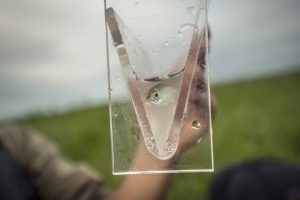
For a moment I breathe in the quiet. Is this what it feels like to be a fish? To float freely in the shelter of the eelgrass beds, warm in the sand flats and salt marsh?
I’m jarred from my reverie as the boat tips. The scientists disembark, preparing for the morning’s work of catching, counting, and measuring.
Raincoast Conservation Foundation (RCF), our partners on this journey, want to know who is where and when. Which different species of salmon come down from the headwaters? What parts of the estuary are they using more? How long they stay?
Their interest extends far beyond the fish. Salmon move through the whole ecosystem. Birds and bear feed on them; their bodies fertilize the forests. And we’re losing them.
We’re losing them.
Lia, a young RCF scientist, is obscured by tall reeds as she records conditions. Misty starts the engine and drives the boat just far enough to drag the seining net across to the opposite bank where Dave and Charlie are primed, ready to haul.
Their motions are clean and quick; muscles strain against the mud and the current. Something gets stuck and Misty moves across the stern of the boat with implausible stealth for someone clad in weighted rubber. Time is of the essence—specimens will be lost if the net lags even for a second.
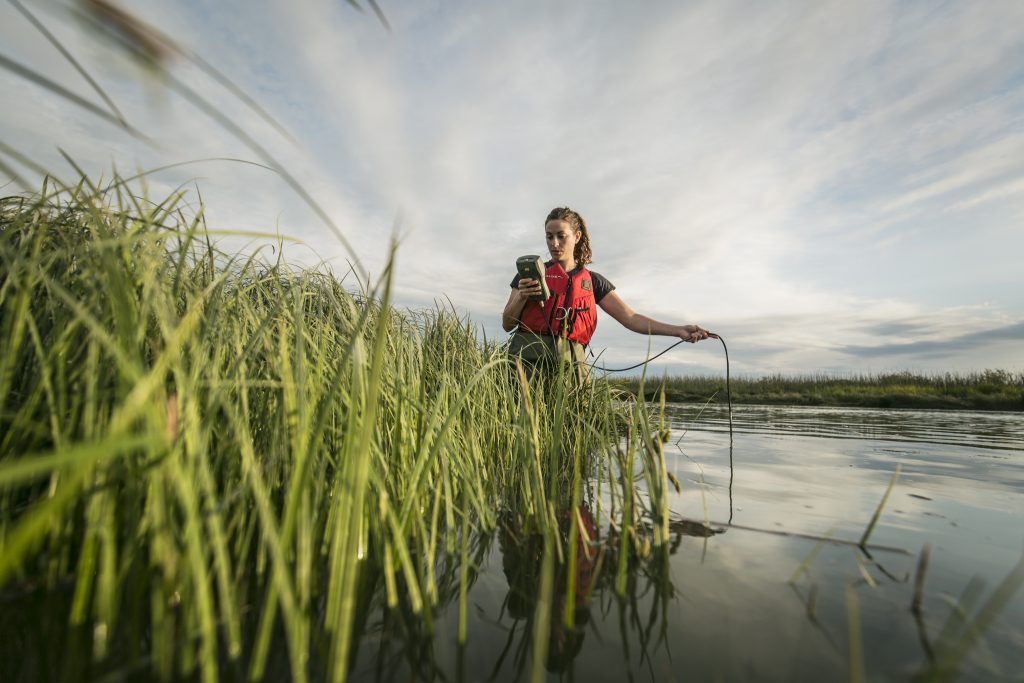
We look on as the scientists take stock of their inventory. Small crustaceans, minute marine life. And there it is. Tiny and glistening, no more than two inches. A Chinook? A chum?
“What’s the body shape?” “Look at his parr marks.” “There, on the right side?” “No adipose.” “It’s June.” “He’s really little.” “His head, it’s pretty chummy.”
A chum. It is determined.
We move through the channel and repeat. Once. Twice. Three times more until the tide turns out of our favor.
Later, back at the field station, the fry goes into the freezer. It is funny, the business of specimens—sacrifice to save.
The field station is a basement apartment built into a hillside in Vancouver’s Richmond suburb. It is furnished only with a few folding tables and chairs, a mattress on the floor here and there. In the freezer beside frozen organic peas and smoothies are baggies with salmon. Nothing to be grilled for dinner though—no, the nymphs will not be eaten.
Lia will look for clues in their ears. Growth rings are laid down in the tiny otoliths each day, ion deposits in the bone material marking migration, like years etched in the trunk of a tree.
What if our ears took count of our years, our fears?
Even in the early summer, the light lasts longer than we’re accustomed, and when the moon doesn’t show until 10 or so my equilibrium spits at me on this strange coast.
It will be 5 a.m. again tomorrow. The bald eagles will be picking at trash heaps; the fry will be pushing their way through the reeds; and the scientists will pull on their waders, throttle the choke on the small boat’s engine, and set to work the business of documenting decline.
***
Part II: Heirlooms and Herons
One branch of the Fraser River’s forked-tongued mouth meets the Salish Sea at the end of Steveson Highway. The long road runs the length of Steveston, a former farm village just beyond Vancouver city limits in Richmond. Tidy, newly-constructed houses with perfectly trimmed hedges now lead the way to the sea. But right before the manicured overlook, a plot of land remains and upon it sits single a farmhouse. This is the home of Harold Steves. His name is no coincidence.
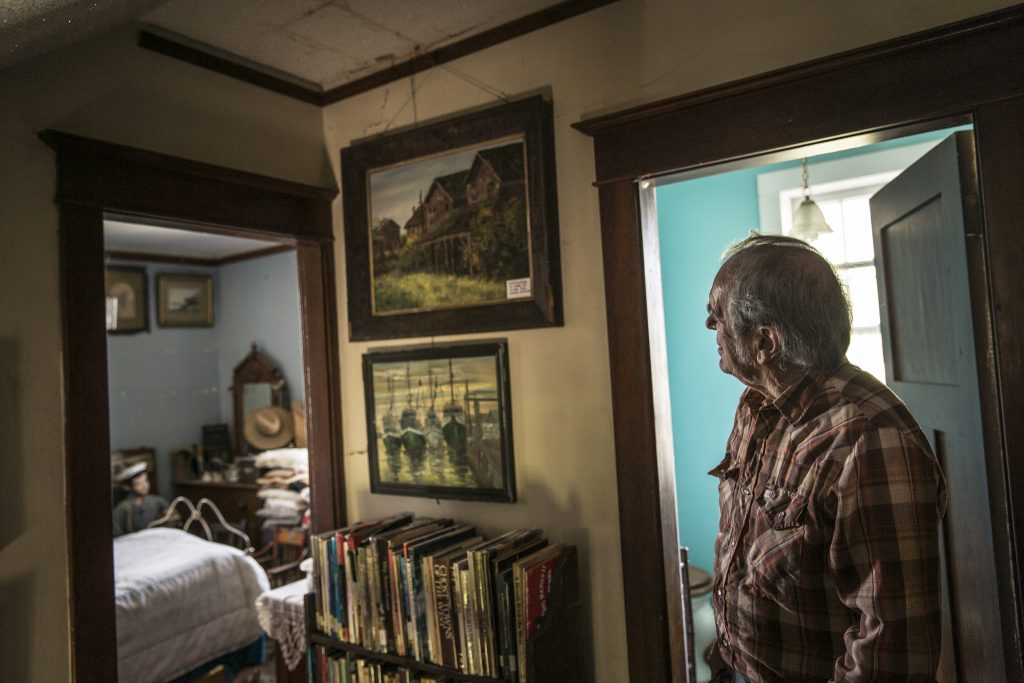
The front porch sags unevenly from age and the slow sinking that happens in tidal areas. A knock at the door goes unanswered. We walk around back to find a woman stooped, following chickens around and between small pens.
Yes, her husband is at home, and yes, of course, come in, come in.
Entering through the kitchen, we find ourselves entering another world. Fish out of water. No surface seems empty, yet the space is less cluttered than curated. Victophones, portraits, books, clocks, odd collectibles, and old toys transport us through time. Faded wallpaper peels from the damp air brought up by the river – the salt marsh.
And at a long wooden table, Harold Steves tells of an era long gone by, but a war he is still fighting.
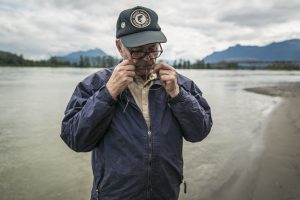
Steves’s family settled the area in the mid-1800s and spent their days and made their living farming and fishing. He remembers the days when salmon spawned beside this very house – before the dikes were built and the slews were cut off. He worked the canneries and he fished. And he saw the salmon populations depleting.
In 1968, Harold was elected to the city council on an environmental ticket – he and his supporters opposed sewage runoff from new development that was negatively impacting the fisheries. They won – that time.
And then the port came along.
That same year, plans were in the works to industrialize the Fraser River. Of course, the salmon, already suffering from overfishing, habitat loss, dikes and development, would feel even more pressure.
They wanted the whole river. And the Minister of Industry announced at that time that the Fraser Valley was going to be industrial all the way from Roberts Banks to Hope. And we said, “the hell it is.”
Harold’s seeds are just part of the next battle. They, like the salmon we’d come to ask him about and like Harold himself, are native to the place and grew in ground fertilized by fish and fowl alike. He is intent on preserving the future by planting seeds of the past.
The delta dikes are a problem; that was clear. But signs – from Misty, other locals, and now Harold – also pointed conspicuously toward the port.
We say our goodbyes and leave the sanctuary of the old farmhouse. With no GPS and no set direction, we let instinct guide us. It takes us to the terminal road. An endless freight train follows the horizon the length of the peninsula, ending at what appears out of the water as a hulking constellation of metal and tarmac, unidentifiable structures, and shipping containers. Not the emerald Oz we’d imagined.
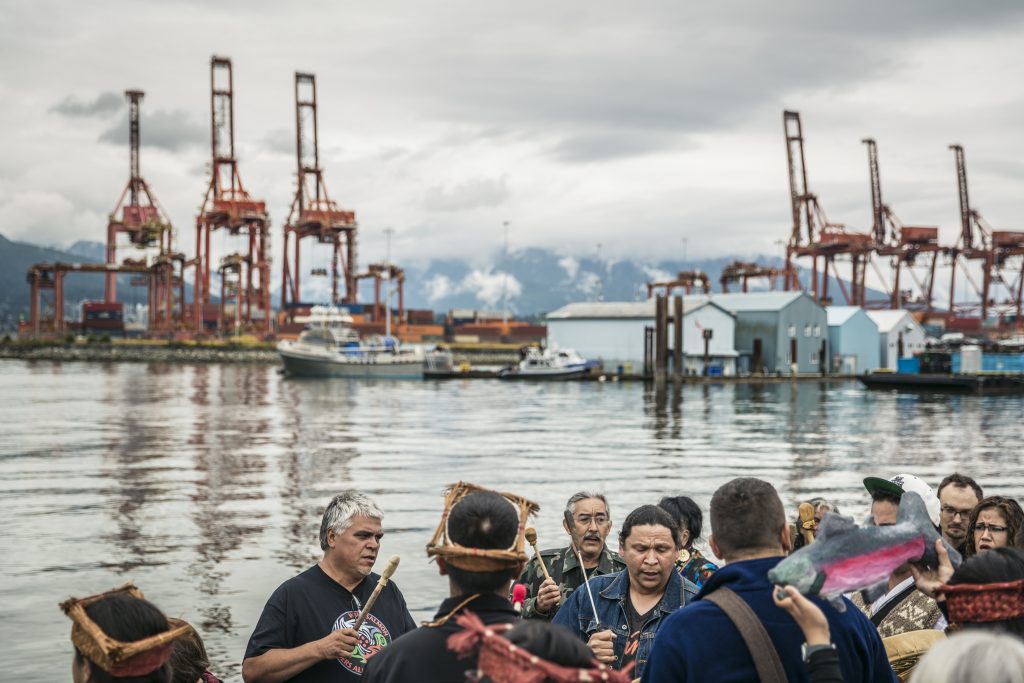
We take the coast road back toward the lab, passing through a First Nations reservation. We stop at a small community center. Where were we? What did we think we were doing here?
We get out of the car and putz around an empty skate park, waiting for kids to show up and tell us something. Anything. They never come.
We stare out across the marsh where the bluff is shifting on the other side of the estuary – undulating slowly as the bows of strange trees hang heavily in the wind, weighed down by the bodies of hundreds of herons waiting to feed.
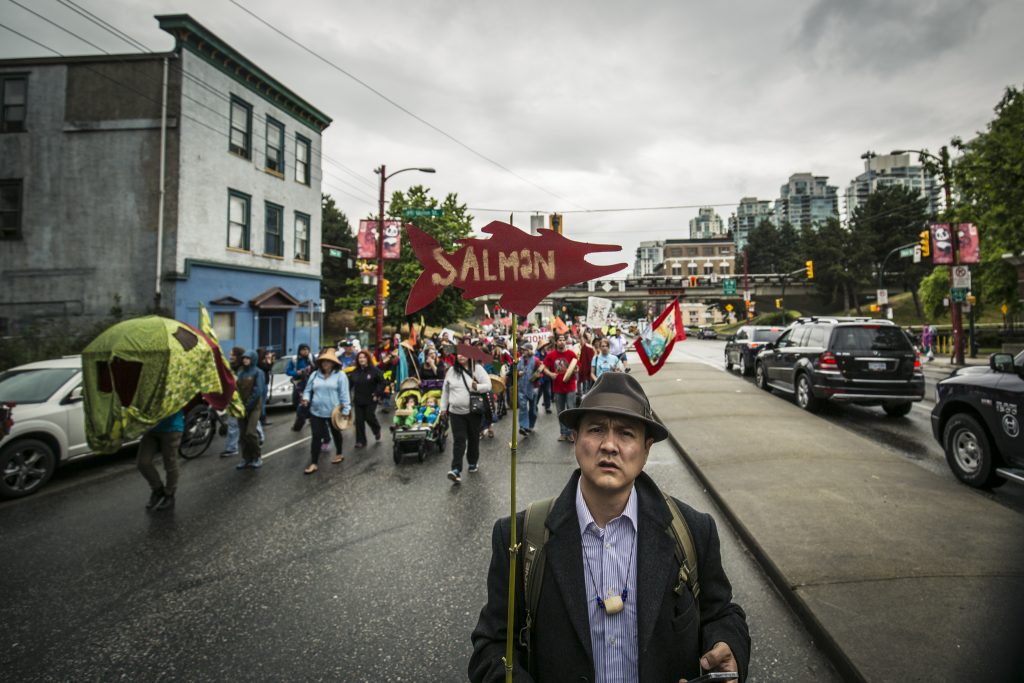
***
Part III: First Ceremony
We are supposed to meet the caravan for a blessing ceremony at the Cheam fishing station. I am with Ross in his beat-up little sedan that is full of more shit – maps, hiking gear, and leftover supplies from a recent expedition – than my ’87 Benz in college. His car smells like lavender because he doused it with essential oils before a date last week. Mike pulls in behind us in our very American rental SUV – own little caravan.
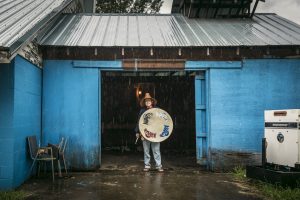
At the far end of the lot lawn chairs and a little grill sit outside an RV.
A few meters out from the beach two boats are chugging along; they are filled with boys – probably college kids – hollering drunkenly across the water, chasing, and throwing around thousands of dollars worth of fishing equipment.
We get out and begin to unpack gear. Even if we’re not in the right spot, Mike will want to get a few shots of this view of the river.
As we start across the gravelly lot, a long-haired man rounds the corner of the distant RV. A small girl dances by his side. He moves slowly and deliberately to the sand beside a tree near the bank, eyes on the water, eyes on the boys in the boats.
Ross searches for cell reception to find out where the caravan is, while Mike and I make our way over to where the stranger stands – his presence draws us toward him; the girl-child a quiet nymph pulling us closer still.
By now the boys on the river are spinning. Their loudness bounces between the tall pines that hold up the bank and those on the island. We’re in the middle of a wide part of the river, and it hurts to hear them, to see them. They’ve got aquatic crotch-rockets, the Fraser is their city freeway, and they are here.
We introduce ourselves to the man – sensitive to the circumstances – we’ve practiced and adjust our approach for each source; each stranger we come across may be able to color in the lines of our story just a little fuller than the last. We’re a photojournalism team from the States doing a story on the Fraser, the salmon, and their significance to B.C. – and to the First Nations people. Read: we come in peace, we’re not assholes.
Sydney is a Sto’lo elder. He is acting as camp warden for the season. The “put-in” for the fishing boats is on what some Americans would call “Res” property – First Nations property. So each season when it starts to warm up and the travelers start to come through someone from the community volunteers to shack up for the summer to monitor the site. Yes, we are in the right place.
Sydney’s granddaughter looks at us curiously. Her short dark hair frames her face as she twists her body from side to side holding onto the fabric at her waist the way little girls do when they are wearing skirts.
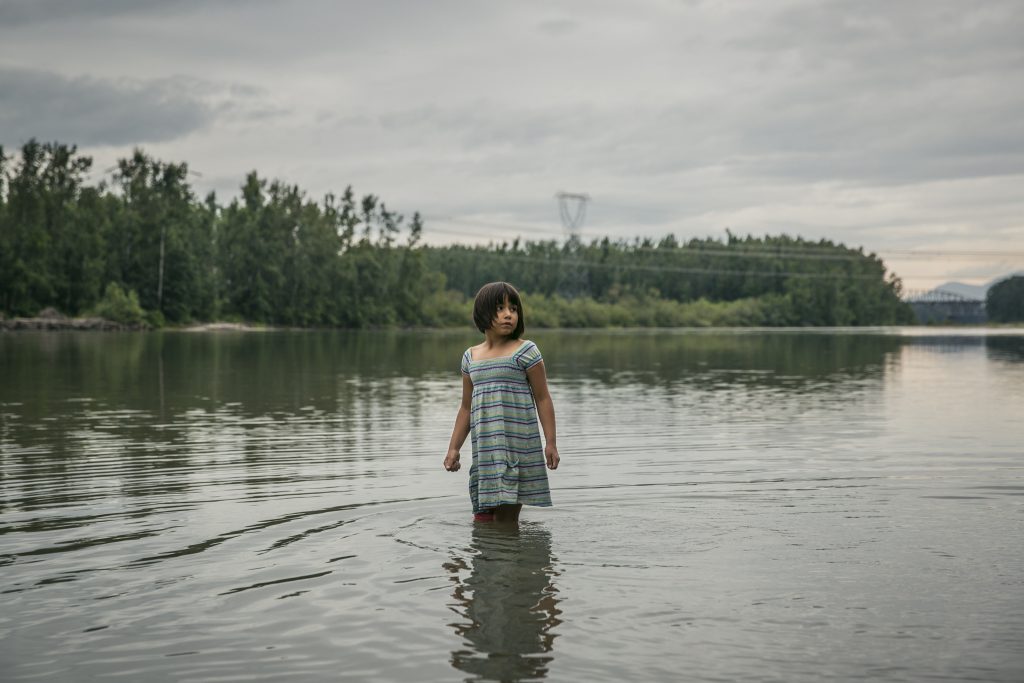
The white boys on the river are still spinning. Loudly, aggressively.
Sydney says they pay hundreds of dollars an hour to charter the boats. Hundreds of dollars an hour to get drunk and chase the salmon around, if there are any to be found.
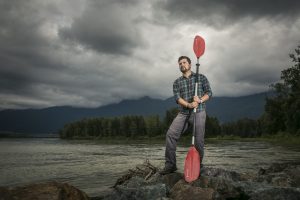
Instead, I look up and out at the mountains that frame the Fraser, a perfect Hudson School painting; something familiar on this unfamiliar coast.
The boys spin. The little girl twirls. Three bright flags screen-printed with tribal art – the open mouths and curved fins of the salmon – are tied to thin poles and cross each other on the beach, waiting to wave the caravan in.